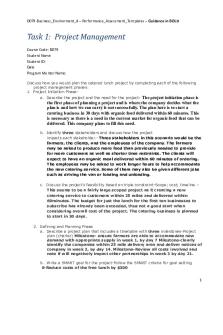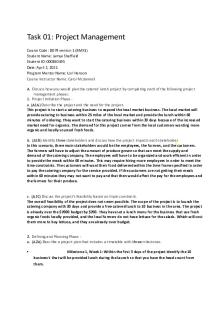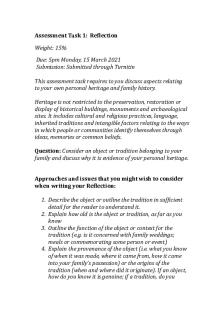C226- Task 1 - la;skfjsa;dlfkj PDF

| Title | C226- Task 1 - la;skfjsa;dlfkj |
|---|---|
| Author | Dwight Williams |
| Course | Jyt2 Task 2 wgu Standards Based Lesson Plan Alignment |
| Institution | Western Governors University |
| Pages | 4 |
| File Size | 132.4 KB |
| File Type | |
| Total Downloads | 37 |
| Total Views | 130 |
Summary
la;skfjsa;dlfkj...
Description
Dwight Williams Student ID: #003546446 Program Mentor: Yen Chea Assessment Code: C226- TASK 1 Research Design & Analysis BFP2- BFP TASK 1: Data Collection Instrument August 2, 2021
Educational-Related Research Topic My research topic is to get a better understanding of common computer/technology proficiency among 9th – 12th grade students in the high school. This is a topic of interest for me since I teach Computer Applications at the high school level. I already give the below survey to my students at the beginning of each semester as a pre-assessment to let me as an educator know what they know and do not know going into the course.
Audience of Data Collection Contributors to the data collection are 9th – 12th grade students that are taking a computer applications class. There are 90 students enrolled in this computer applications consisting of three separate classes, 30 in each class. There are 9th - 12th graders within these classes. The majority of students are freshman as it is suggested that incoming freshman take computer applications because it will help them throughout their high school career.
Purpose of the Data Collection Instrument The data collection will be given through an online questionnaire using Google documents. The Computer Literacy Survey will consist of 25 questions that contributors will choose the answer that best represents their opinion of themselves and knowledge of the particular question. Answers will be chosen from a Likert-scale list of 1 to 5. This data collection will quantify what individuals’ knowledge are in regard to computer literacy.
Type of Data Collected There will be an ordinal value to each response. Students can choose from five different responses on a Likert-scale: 5 (strongly agree), 4 (agree), 3 (neutral), 2 (disagree), 1 (strongly
disagree). The below survey will consist of answers from the below collection instrument and the data collected will be quantitative.
Instructions: Please check the box that best represents your opinion/ability on the topic. 5 (strongly agree), 4 (agree), 3 (neutral), 2 (disagree), 1(strongly disagree).
Computer Literacy Survey Topics 1 2 3 4 5 Basic Computer Operations - - - - 1. Logging on and off a computer 2. Powering on and off a computer 3. Opening and closing applications on desktop 4. Opening and saving file documents 5. Printing documents/spreadsheets 6. Identifying the main parts of a computer 7. Adjusting volume and brightness controls 8. Inserting and removing media input devices Using Word Processing Software - - - - 9. Starting/opening a new word document 10. Saving a word document 11. Using icons and menus in Word 12. Typing or entering text on a document 13. Selecting and editing text on a document 14. Changing font sizes 15. Changing font styles 16. Cut/copy/pasting text within a document 17. Using undo and redo 18. Formatting text in a Word document Using Spreadsheet Software - - - - 19. Opening a new spreadsheet 20. Saving a spreadsheet 21. Using icons and menus within a spreadsheet 22. Typing text into cells 23. Access/use basic formulas 24. Merging and centering cells 25. Printing a selected area
Ethical Issues/Process Issues Adhering and following ethical issues guidelines is very important when collecting data from individuals within a survey. Informed consent and confidentiality are important to adhere by when conducting the above survey. We as a business department make sure that one of our administrators contact the parents of the students about the nature of the survey before the students take it. These ethical issues will be addressed by: 1. Contributors to the survey will be given the option not to take the survey. 2. Contributors parents will be directly contacted via email by an administrator and the parents must sign a form that must be returned to the teacher in order for their son/daughter to take the survey in class. 3. Contributors to the survey will be told the purpose of the survey. 4. Contributors to the survey will be told that their responses are anonymous. 5. Contributors to the survey will be informed that no personal information will be saved. 6. Contributors to the survey responses will not be used for categorical connecting....
Similar Free PDFs

Task 1 - C226 Task 1
- 11 Pages

Task 2 - C226 Task 2
- 7 Pages

C226- Task 1 - la;skfjsa;dlfkj
- 4 Pages

PCE Task 1 - Task 1
- 2 Pages

Task 1 - SUS101 Task 1
- 2 Pages

Qht1 task 1 - Task 1
- 3 Pages

QBM1 Task 1 - Task 1
- 5 Pages

C365 - Task 1 - Task 1
- 4 Pages

C304 Task 1 - TASK 1
- 16 Pages

DIT1 TASK 1 - Task 1
- 4 Pages

D078 Task 1 - task 1
- 2 Pages

Task d079 copy - Task 1
- 3 Pages

HMc Daniel Task 1 - Task 1
- 9 Pages
Popular Institutions
- Tinajero National High School - Annex
- Politeknik Caltex Riau
- Yokohama City University
- SGT University
- University of Al-Qadisiyah
- Divine Word College of Vigan
- Techniek College Rotterdam
- Universidade de Santiago
- Universiti Teknologi MARA Cawangan Johor Kampus Pasir Gudang
- Poltekkes Kemenkes Yogyakarta
- Baguio City National High School
- Colegio san marcos
- preparatoria uno
- Centro de Bachillerato Tecnológico Industrial y de Servicios No. 107
- Dalian Maritime University
- Quang Trung Secondary School
- Colegio Tecnológico en Informática
- Corporación Regional de Educación Superior
- Grupo CEDVA
- Dar Al Uloom University
- Centro de Estudios Preuniversitarios de la Universidad Nacional de Ingeniería
- 上智大学
- Aakash International School, Nuna Majara
- San Felipe Neri Catholic School
- Kang Chiao International School - New Taipei City
- Misamis Occidental National High School
- Institución Educativa Escuela Normal Juan Ladrilleros
- Kolehiyo ng Pantukan
- Batanes State College
- Instituto Continental
- Sekolah Menengah Kejuruan Kesehatan Kaltara (Tarakan)
- Colegio de La Inmaculada Concepcion - Cebu


